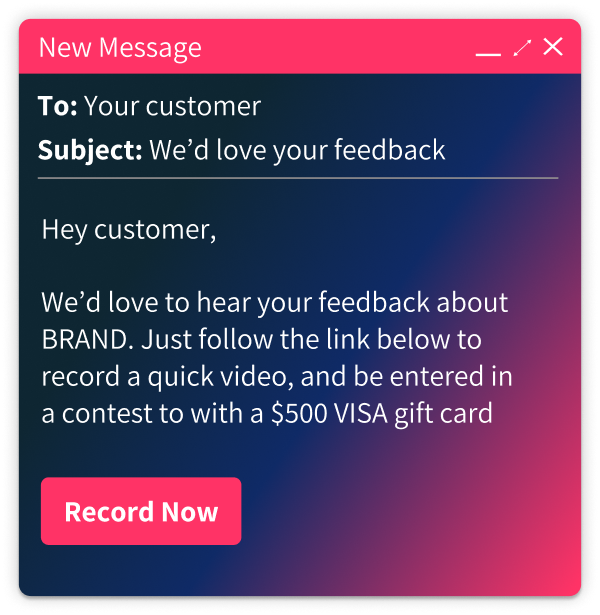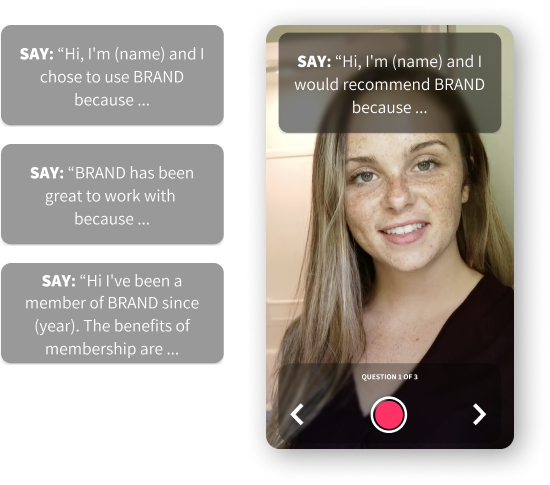BEST PRACTICES FROM 10+ YEARS
Guide to Video Testimonials in 2025

Over the past 10 years, we at StoryTap have been working with brands of all sizes from global enterprises to mom & pop shops, capturing video testimonials and real stories – driving engagement, conversions, policy changes, and ultimately trust.
This guide is a compilation of what we have learned with best practices you can implement today. What are you waiting for, get reading 👇
How to Easily Produce Ongoing Video Testimonials & Supercharge Your Brand
Welcome to the golden age of binge-watching, where your customers scroll, stop, and consume content in a split second. Every platform, from TikTok to YouTube Shorts to LinkedIn, has doubled down on vertical video, because it works.
And LinkedIn’s marketing team? They’ve cracked the code. Their content – and even their paid media – is increasingly vertical, personal, and story-driven. Why? Because it converts. The modern consumer wants stories, not slogans. They want real people, not polished ads. And they want it now.
If you’re serious about grabbing attention and building social proof, ongoing video testimonials are your brand’s superpower. Not the old-school kind with a film crew and three rounds of approvals. We’re talking about effortless, daily videos from real customers, captured and published at scale. This guide lays out the blueprint to make that happen, without burning out your team or your budget.
The Best Practices

#1
Never Ask for a Testimonial
Here’s the thing: no one wants to give you a testimonial. The word itself triggers a mental image of a camera crew, a full day off work, and possibly a performance anxiety spiral. And in the B2B world, “testimonial” often means a multi-week legal process that drains all momentum by the time it’s approved.
So don’t ask for a testimonial. Ask for feedback. Ask for their thoughts. Ask what surprised them about your product or service. Ask what they’d tell a friend. That simple language shift removes pressure and invites honesty, and yes, the positive stories will still come through loud and clear. You might also get the occasional piece of constructive criticism, which is a gift in itself. In a world driven by authenticity, feedback is the new testimonial.

#2
Automate the Ask at the Right Time
The key to ongoing video content is removing the manual effort from your team. You don’t need a new campaign every time you want video. Instead, build testimonial requests directly into your customer journey and let it run in the background. Add a QR code to your receipts, invoices, or packaging with a prompt like “Tell us what you think”. Trigger a follow-up email or SMS a few days after delivery. Drop a friendly nudge at the end of a support interaction. Even a monthly check-in asking for feedback can yield gold.
The point is: don’t overthink it. Just like you automate review requests or NPS surveys, you can automate testimonial collection – especially if you’re using a video platform like StoryTap that are built for scale. When done right, it becomes a machine that feeds your content strategy daily, without added stress to your team.

#3
Incentivize Strategically
While some superfans will gladly send in a video out of pure brand love, the majority of your customers know their video has value. It’s user-generated gold, and they expect something in return. That’s where incentives come in. You don’t need to offer thousands in prizes, but you do need to show appreciation. Credit their account. Add loyalty points. Enter them into a “record & win” contest. Offer a freebie or sneak preview. If it’s a item they buy repeatedly, offer a discount on the next purchase. Just make the trade clear.
You can also piggyback off systems you already have in place. Got a loyalty program? Plug testimonial collection into that. Running regular giveaways? Make video entries the new standard. And if you’re using a video testimonial platform like StoryTap, use their included incentives, making it seamless to reward your customers and drive ongoing content without lifting a finger.
Want to read more about leveraging incentives? Check out this recent blog post.

#4
Make it Easy
Customers don’t want to look awkward, unprepared, or worse, dumb. That fear stops more video submissions than you think. So take the anxiety out of it. Tell them what to do. What should they wear? Where should they stand? What should they talk about? Once people are briefed with a few clear cues, they’re good to go.
You can help by outlining story prompts in plain language. For example: “Tell us about the moment you knew this was the right product for you.” Or: “What problem did we solve for you?” Don’t overload them with a script, just give them enough structure to feel confident. The easier you make it, the better the video (and the higher your conversion rate). No editing skills required, just a smartphone and a little guidance.

#5
Keep it Short
The sweet spot for most testimonial videos is 45–60 seconds. That means your ask should only take 3–5 minutes of the customer’s time, including a couple of redos. Anything longer than that feels like a chore. In fact, the biggest myth in video marketing is that longer equals better. Not true. Short is sticky. Short gets watched. And short gets shared.
Let customers know upfront how quick and simple it will be. “No editing needed. Just shoot a quick selfie-style video and you’re done.” The less friction you create, the more likely they are to hit record. Tools like StoryTap are built for this kind of short-form, guided video capture – helping customers record and submit a usable testimonial in minutes, without an app download or tech headaches.

#6
Own the Rights Forever
You need full rights to reuse the content your customers provide – on social, on your website, in paid ads, and anywhere else your brand shows up. That means having a clear, simple agreement as part of the process. No dense legalese. No separate paperwork. Just a friendly release that explains what you’ll use their video for and gets their consent in plain English.
It’s important to remember: these aren’t influencers or actors. They’re your everyday customers. So don’t make it complicated or intimidating. Your tech should handle the details automatically, so all you’re left with is authentic, reusable content that you can tap into for years to come.

#7
Be realistic
Let’s be real. Not everyone will record a video, and that’s not the goal. You’re not aiming for 100%. You’re aiming for consistency.
What does success look like? Think ongoing, daily video testimonials. Marketing greats like Gary Vee suggest 20 videos per day to stay competitive in today’s content economy. But let’s be practical. If you start with just one testimonial video a day, you’re ahead of most brands.
If your ask is well-targeted, you can expect a 2–5% conversion rate from request to video. If you’re offering something wild, like a free trip to Europe, you might get 50% (but that’s a very different strategy).
Point is, you don’t need everyone. You just need enough, and you need it to be ongoing.


The Final Word
The future of marketing is vertical, authentic, and human. Video testimonials deliver all three. They build trust, drive conversions, and give your brand a human voice that cuts through the noise. But they won’t happen by accident.
With the right process, the right tech, and a strategy that respects your customers’ time and experience, video testimonials can become your most powerful and scalable content asset.
Next Steps
If you’re interested in learning more about StoryTap, or just exploring more video best practices, here are some next steps you can take.
Talk to us
Book a demo with the StoryTap team to see how our Video Platform can support your unique needs.
Get Started
Try StoryTap for free today. Sign up now to get 5 videos and see the Video Platform in action.
Learn More
Explore our Blog and learn more about video, from b-roll to incentives, and everything in between.
Stay Connected
Sign up for our periodic newsletter to stay up-to-date on important updates and more.